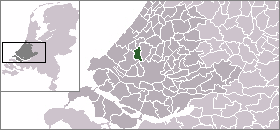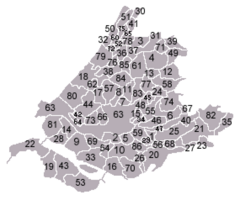Delft
See also: Delft, Cape Town
| Delft | |||
|
|||
 |
|||
| Coordinates: | |||
| Country | Netherlands | ||
|---|---|---|---|
| Province | South Holland | ||
| Area (2006) | |||
| - Total | 24.08 km² (9.3 sq mi) | ||
| - Land | 23.21 km² (9 sq mi) | ||
| - Water | 0.87 km² (0.3 sq mi) | ||
| Population (1 January, 2008) | |||
| - Total | 96,168 | ||
| - Density | 4,180/km² (10,826.2/sq mi) | ||
| Source: CBS, Statline. | |||
| Time zone | CET (UTC+1) | ||
| - Summer (DST) | CEST (UTC+2) | ||
![]() Delft is a city and municipality in the province of South Holland (Zuid-Holland), the Netherlands. It is located in between Rotterdam and The Hague. Delft is primarily known for its typically Dutch town centre (with canals); also for the painter Vermeer, Delft Blue pottery (Delftware), the Delft University of Technology, and its association with the Royal Family.
Delft is a city and municipality in the province of South Holland (Zuid-Holland), the Netherlands. It is located in between Rotterdam and The Hague. Delft is primarily known for its typically Dutch town centre (with canals); also for the painter Vermeer, Delft Blue pottery (Delftware), the Delft University of Technology, and its association with the Royal Family.
Contents |
History

The city dates from the 13th century. It received its charter in 1246.
The association of the House of Orange with Delft began when William of Orange (Willem van Oranje), nicknamed William the Silent (Willem de Zwijger), took up residence there in 1572. William was the leader at the time in the struggle against the Spanish, the Eighty Years' War.
Delft was one of the leading cities of Holland and was equipped with the necessary city walls to serve as a headquarters. When William was shot to death in 1584 by Balthazar Gerards in the hall of the Prinsenhof, the family's traditional burial place in Breda was in the hands of the Spanish. He was buried in the Nieuwe Kerk (New Church), starting a tradition for the House of Orange that has continued to the present day.
Delft Explosion

A View of Delft after the Explosion of 1654
The Delft Explosion, also known in history as the Delft Thunderclap, occurred on October 12 1654 when a gunpowder store exploded, destroying much of the city. Over a hundred people were killed and thousands wounded.
About 40 tonnes of gunpowder were stored in barrels in a magazine in a former Clarissen convent in the Doelenkwartier district. Cornelis Soetens, the keeper of the magazine, opened the store to check a sample of the powder and a huge explosion followed. Luckily, many citizens were away, visiting a market in Schiedam or a fair in The Hague. Artist Carel Fabritius was wounded in the explosion and died of his injuries. Afterward, Egbert van der Poel painted several pictures of Delft showing the devastation.
Sights


The city center retains many old and historical buildings, and many streets have canals in the center, inhabited by fish and plants making this small city a tourist destination and a beautiful small city. Historical buildings include:
- Oude Kerk (Old Church). Buried here: Piet Hein, Johannes Vermeer, Anthony van Leeuwenhoek.
- Nieuwe Kerk (New Church), constructed between 1381 and 1496. It contains the Dutch royal family's burial vault, which between funerals is sealed with a 5000 kg cover stone.
- The Prinsenhof (Princes' Court), now a museum.
- City Hall.
- The Oostpoort (Eastern gate), built around 1400. This is the only remaining gate of the old city walls.
- The Gemeenlandshuis or Huyterhuis, built in 1505, which houses the regional water authority Delfland since 1645.
- Waag (Delft)
Culture
Delft is well known for the Delft pottery ceramic products which were styled on the imported Chinese porcelain of the 17th century. The city had an early start in this area since it was a home port of the Dutch East India Company.
The painter Johannes Vermeer (1632-1675) was born in Delft. Vermeer used Delft streets and home interiors as the subject or background of his paintings.
Several other famous painters lived and worked in Delft at that time, such as Pieter de Hoogh, Carel Fabritius, Nicolaes Maes, Gerard Houckgeest and Hendrick Cornelisz. van Vliet. They all were members of the Delft School. The Delft School is known for its images of domestic life, views of households, church interiors, courtyards, squares and the streets of Delft. The painters also produced pictures showing historic events, flower paintings, portraits for patrons and the court, and decorative pieces of art.
Education
Delft University of Technology (TU Delft) is one of three universities of technology in the Netherlands. It was founded as an academy for civil engineering in 1842 by King William II. Today well over 16,000 students are enrolled.
The UNESCO-IHE Institute for Water Education, providing postgraduate education for people from developing countries, draws on the strong tradition in water management and hydraulic engineering of the Delft university.
Recreation
East of Delft is the Delftse Hout ("Delft Wood") recreation area, with a lake (suitable for swimming and windsurfing), narrow beaches, a small nudist area (not fenced off), restaurant, community gardens, campground and other recreational and sports facilities. Noise from the nearby A13/E19 highway can be heard throughout the area.
Well-known persons
Natives
Delft was the birthplace of several internationally well known persons:
- Michiel Jansz. van Mierevelt (1567-1641), painter
- Hugo Grotius (1583-1645), the lawyer who laid the foundations for international law
- Martin van den Hove (1605-1639), astronomer and mathematician
- Hendrick Cornelisz. van Vliet (1611 or 1612-1675), painter
- Antonie van Leeuwenhoek (1632-1723), father of microbiology and developer of the microscope
- Johannes Vermeer (1632-1675), painter
- Leonaert Bramer, painter
- Stien Kaiser-former speed skater
- Michaëlla Krajicek-professional tennis player.
- Roel van Velzen - singer, songwriter, piano player
Otherwise related
- Jan Timman chess grandmaster, was raised in Delft.
Sister cities
 Esteli, Nicaragua
Esteli, Nicaragua Pretoria, South Africa
Pretoria, South Africa Aarau, Switzerland
Aarau, Switzerland Adapazarı, Turkey
Adapazarı, Turkey Freiberg, Germany
Freiberg, Germany Kfar Saba, Israel (since 1968)
Kfar Saba, Israel (since 1968) Tuzla, Bosnia and Herzegovina
Tuzla, Bosnia and Herzegovina Kingston upon Thames, The United Kingdom
Kingston upon Thames, The United Kingdom
(source: Delft municipality guide 2005)
Transportation
- Delft railway station
- Delft Zuid railway station
See also
- Delftware
- Johannes Vermeer
- William the Silent
- Dutch Golden Age
- Dutch East India Company
- Eastern Gate (Delft)
- Delft University of Technology
- World Solar Challenge
- Tanthof
- SRC Thor
External links
- Delft travel guide from Wikitravel
- Municipal Website of Delft
- Radio Netherlands: The day the world came to an end
- National Gallery, London: A View of Delft after the Explosion of 1654
- Delft University of Technology
Further reading
- Vermeer: A View of Delft, Anthony Bailey, Henry Holt & Company, 2001, ISBN 0-8050-6718-3
|
|||||||


